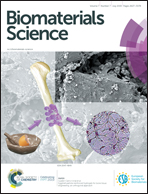The development of tertiary amine cationic lipids for safe and efficient siRNA delivery†
Abstract
Cationic liposomes have shown great potential in efficient siRNA delivery, and their positive charge is crucial for tight extracellular siRNA binding, effective intracellular siRNA disassembly and physiological toxicity. Thus, the development of novel cationic lipids with a suitable positive charge is desirable for safe and efficient siRNA delivery. Herein, we fabricated a library of 21 tertiary amine-derived cationic lipids (TA) to achieve a balance between effectiveness and safe siRNA delivery. The screened TA13 liposomes, which consisted of TA13 and helper lipid DOPE at a mole ratio of 1 : 1, readily condensed siRNA to form lipoplexes (TA13 LPs), achieving stronger gene silencing in diverse cells than the commercially available vector Lipo2000. Moreover, the TA13 LPs demonstrated effective in vivo gene silencing and good safety in normal mice. The improved gene silencing efficiency of the TA13 LPs is ascribed to their capability of sequentially conquering the barriers met by in vivo siRNA delivery. Notably, the TA13 LPs delivered ApoB-siRNA and obviously decreased ApoB mRNA expression in the liver and the total cholesterol and low-density lipoprotein in the serum of hypercholesterolemia mice, indicating a potential siRNA therapeutic for hypercholesterolemia treatment. It is anticipated that these novel tertiary amine-based liposomes can provide a simple and widely-used platform for the safe and effective delivery of siRNA, and their structure–activity relationships can aid in the further development of effective cationic lipids.



 Please wait while we load your content...
Please wait while we load your content...